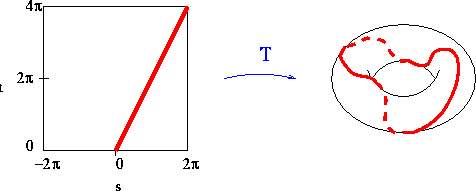with(plots): with(linalg):
Recall that a torus may be parametrized by rotating a circle of radius r about another circle of radius R. For concreteness, let r=1 and R=2. Then a parametrization of the torus may be written:
T(s,t) = ( (2+cos(t))cos(s), (2+cos(t))sin(s), sin(t) )
In Maple, such a function would be written as
T:=(s,t)-> [(2+cos(t))*cos(s),(2+cos(t))*sin(s),sin(t)];
Note that the image of T is in R^3 whereas the domain of T is in the plane.
A torus knot is a closed curve that winds around the torus.
You can generate torus knots by specifying an integer relationship between
the parameters s and t. For example, if
we restrict T to the curve t=2s, then we get a
parametrized curve
T(s,2s) = ( (2+cos(2s))cos(s), (2+cos(2s))sin(s), sin(2s) )
This curve wraps around the torus once in the "long" direction while it wraps around the torus two times in the "short" direction, as indicted in Figure 1.

spacecurve(T(s, 2*s), s=0..2*Pi);
to plot the torus knot. You can try to display this along
with a plot of the torus,
plot3d(T(s,t),s=0..2*Pi,t=0..2*Pi);
but the results are not very satisfying.
In general, for nonzero integers m,n, a torus knot of type (m,n) is the image of the line ns=mt + const. (The constant moves the knot around, but doesn't change the way that it winds.) This image will wind around the torus m times in one direction and n times in the other direction. If either m=0 or n=0, then the definition changes slightly: a torus knot of type (1,0) is the image of the line t=constant whereas a knot of type (0,1) is the image of a line s=constant.
Document Created: Thu Feb 23 1995
Last modified: Mon Mar 10 16:56:20 1997